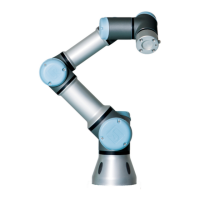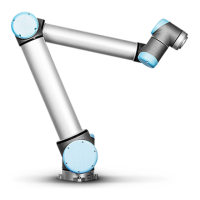13.2 Program Tab
13.2.4 Program Dashboard
The lowest part of the screen is the Dashboard. The Dashboard features a set of but-
tons similar to an old-fashioned tape recorder, from which programs can be started
and stopped, single-stepped and restarted. The speed slider allows you to adjust the
program speed at any time, which directly affects the speed at which the robot arm
moves. Additionally, the speed slider shows in real time the relative speed at which the
robot arm moves taking into account the safety settings. The indicated percentage is
the maximum achievable speed for the running program without violating the safety
limits.
To the left of the Dashboard the Simulation and Real Robot buttons toggle between
running the program in a simulation, or running it on the real robot. When running in
simulation, the robot arm does not move and thus cannot damage itself or any nearby
equipment in collisions. Use simulation to test programs if unsure about what the
robot arm will do.
DANGER:
1. Make sure to stay outside the robot workspace when the Play
button is pressed. The movement you programmed may be dif-
ferent than expected.
2. Make sure to stay outside the robot workspace when the Step
button is pressed. The function of the Step button can be diffi-
cult to understand. Only use it when it is absolutely necessary.
3. Make sure to always test your program by reducing the speed
with the speed slider. Logic programming errors made by the
integrator might cause unexpected movements of the robot arm.
4. When a emergency stop or protective stop has occured, the
robot program will stop. It can be resumed as long as no joint
has moved more than 10
◦
. When pressing play, the robot will
move slowly back onto the trajectory, and continue program ex-
ecution.
While the program is being written, the resulting motion of the robot arm is illustrated
using a 3D drawing on the Graphics tab, described in 13.28.
Next to each program command is a small icon, which is either red, yellow or green.
A red icon means that there is an error in that command, yellow means that the com-
mand is not finished, and green means that all is OK. A program can only be run when
all commands are green.
CB3 II-48 Version 3.1 (rev. 17782)
Copyright © 2009-2015 by Universal Robots A/S. All rights reserved.

